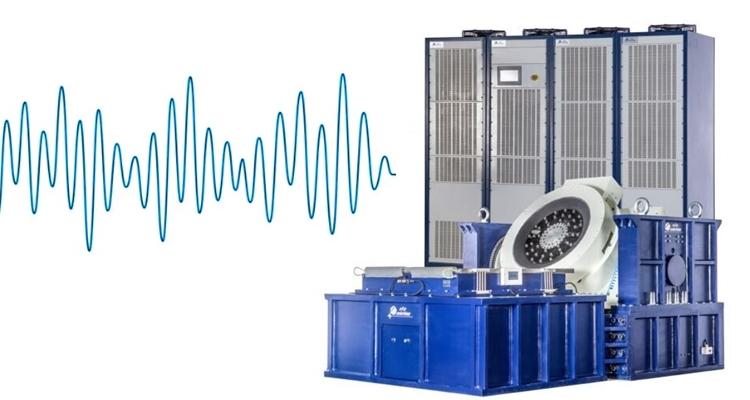Vibration Testing: An Overview of Techniques and Applications
Different types of vibration tests are used to simulate real-world conditions and assess the durability and reliability of products. Our latest blog looks at some common types of vibration tests, when to use them, and how they are performed:
Sine Vibration Testing:
Purpose:
Sine vibration tests are used to replicate harmonic vibrations encountered in products during transportation, operation, or other scenarios. They are used to evaluate resonance frequencies, structural weaknesses, and dynamic responses but they may not precisely reflect real-world usage scenarios. It is particularly relevant in industries where products experience repetitive vibrations, such as consumer electronics, automotive, and aerospace.
Applications:
- Consumer Electronics: Assessing the reliability of smartphones, laptops, and other handheld devices under constant movement.
- Automotive Components: Evaluating the durability of suspension systems, engine components, and infotainment systems.
- Aerospace: Testing avionics, sensors, and onboard equipment subjected to constant vibrations during flight.
How it's Done:
A single-frequency sine wave at a pre- determined acceleration level is applied to the test specimen using a shaker or vibration table. The frequency and acceleration level can be gradually increased or decreased to observe the specimen's response over a specific frequency bandwidth.
Random Vibration Testing:
Purpose:
Random vibration tests simulate real-world, non-harmonic vibrations, such as those experienced during vehicle transportation or machinery operation. This test helps identify structural weaknesses and weak spots in a product. It is essential in industries where products encounter irregular movement and mechanical stress.
Applications:
- Electronics: Assessing how a product's internal components withstand random vibrations during shipping and handling.
- Automotive: Testing the robustness of a vehicle's structure and components against road irregularities.
- Aerospace: Ensuring that aircraft components can endure turbulence and sudden shocks during flight.
How it's Done:
Random vibration tests use a broadband spectrum of frequencies and amplitudes. The vibration controller generates a random waveform, which is applied to the product under test.
Shock Testing:
Purpose:
Shock testing assesses a product's ability to withstand sudden, high-impact events like drops or crashes. It is essential in industries where products are exposed to mechanical shocks, such as transportation and military applications.
Applications:
- Consumer Goods: Ensuring that fragile products can endure shipping and handling, e.g., electronic devices and glassware.
- Automotive: Assessing the impact resistance of airbags and vehicle safety systems, engine management systems, lights and interiors.
- Military and Defence: Testing equipment like ruggedised computers, ammunition, and armoured vehicles for battlefield conditions.
How it's Done:
Shock testing involves subjecting a product to controlled, high-acceleration impulses to determined levels and durations, taking many different forms such a classic half sine, trapezoidal, terminal or initial peak amongst others. A shock pulse is applied using a shock machine or a multi-purpose electro-dynamic shaker with a large displacement, and the product's response is monitored.
Sine on Random Testing:
Purpose: This combines both sine and random vibrations to simulate realistic scenarios where a product experiences both steady-state and unpredictable vibrations, like in automotive or aerospace applications.
Applications:
- Electronics: Assessing the response of a product when it experiences periodic vibrations (e.g., due to machinery) combined with random vibrations (e.g., during transportation).
- Automotive: Evaluating the resilience of a vehicle's components subjected to engine vibrations and road-induced random vibrations.
How it's Done: Sine tones are superimposed on a random vibration background to replicate complex vibration profiles.
Resonance Search and Dwell Testing:
Purpose: This test identifies resonant frequencies and how a product reacts when exposed to them. It's useful for ensuring products can withstand resonant vibrations.
Applications:
- Aerospace: Identifying critical resonant frequencies in aircraft components that can lead to catastrophic failure.
- Structural Engineering: Assessing buildings, bridges, and other structures for resonance-related vulnerabilities.
How it's Done: The frequency is swept through a range, and when a resonance is encountered, it's "dwelled" upon to assess the product's response.
A low level sine sweep Is carried out across a frequency range to identify those frequencies where the payload is resonating. A fixed frequency dwell is run at those frequencies identified to be a resonant. The fixed dwell will be run for a determined number of cycles or time, and the payload will be observed to look for changes in response due to material fatigue or weaknesses.
Combined Environmental Testing
Purpose:
Combined environmental testing subjects a product to multiple environmental stress factors simultaneously. It helps in assessing a product's resilience under complex conditions.
Applications:
- Consumer Electronics: Ensuring smartphones, laptops, and wearables can withstand temperature variations, humidity, and vibration during real-world use.
- Automotive: Testing the durability of vehicles under combined effects of temperature, humidity, and vibrations.
- Aerospace: Assessing avionics, sensors, and equipment in an environment that mimics the conditions during flight.
How it’s Done:
Combined environmental testing involves replicating a range of environmental factors simultaneously. This may include controlling temperature and humidity chambers, vibration tables, and other equipment to subject the product to the desired conditions. Sensors are placed on the product to monitor its response to the combined stressors. Data collected during the test is analysed to evaluate the product's performance under these complex conditions.
When choosing the appropriate vibration test, consider the application, industry standards, and the specific characteristics of your product. Vibration testing is crucial for ensuring product durability, reliability, and compliance with safety regulations.

